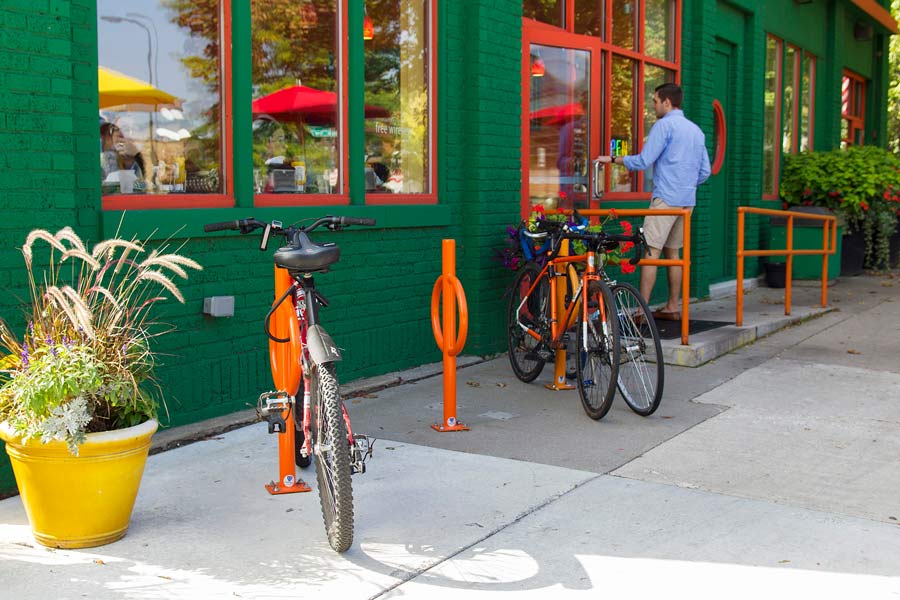Note: Originally published on January 16th, our friends at the Minneapolis Bicycle Coalition posted this insightful interview about secure bike parking with Dero VP & General Manager Andy Lageson. Founded in 2009, MBC advocates for a city where bicycling is encouraged and everyone feels comfortable riding.
Getting your bike stolen can be devastating, especially if it’s your primary way of getting around. While you can minimize your risk by using a quality lock, and increase your chance of getting a stolen bike back by registering your bike with the police; where you park your bike matters too. We asked Andy Lageson, VP and General Manager of local company Dero Bike Racks about how they’re working to make bike parking more secure in Minneapolis.
What are the most common reasons bikes get stolen in Minneapolis?
Andy: Making the right bike lock purchase is key to deter bike thieves. Using the wrong type of lock is the most common mistake made by cyclists. We recommend that people only use U-locks or non-cable bike locks, such as
Kryptonite chains or the
Abus folding locks. Never use just a cable lock; they are quickly and easily cut. A cable lock should only be used in conjunction with a U-lock or chain.
It’s also important to be aware of what you’re locking your bike to and how you’re securing your bike. No matter what, always lock your bike – I know it’s tempting to run into your favorite store and leave the bike unlocked for a minute, but it’s just not a good idea…always lock your bike, even if it’s just for 30 seconds. A lot of theft occurs because of this split-second decision.
Recently The Oregonian ran an article about a new trend in bike thieves cutting through bike racks to steal bikes. Has that been an issue you’ve seen with bike racks in Minneapolis? Are the racks Portland uses similar to the Dero racks the City of Minneapolis uses?
Andy: I think we’ve been pretty lucky in the Twin Cities metro area. We haven’t met with these types of issues here much. Based on the photo from the article, someone used a pipe cutter to steal the bike. (Counter to the article’s assumption, the cut is too smooth to be a saw.) Portland uses a bike rack manufacturer in the Northwest that uses a lighter gauge material for their racks – they probably used this based on cost issues. The bike racks that Dero manufactures use a heavier duty schedule 40 steel pipe. Both racks are susceptible to a pipe cutter, but a heavier duty rack will take longer to cut and may deter bike thieves.
Another issue is that the bike racks use round pipe, which thieves can cut with a pipe cutter. Any racks that are inverted-U racks or hoop racks made with round pipe are at risk to pipe cutting. The
Dero Bike Hitch Rack that the City of Minneapolis uses won’t work with pipe cutters, since the pipe cutting tool can’t spin all the way around the locking arms (this is good news).

One of the suggestions in that article is filling bike racks with concrete to make them more secure. Is that something Dero has considered, and what other technologies might work better to stop bike thieves?
Andy: We’ve experimented with filling our
Hoop Racks internally with concrete and that was a nightmare. It’s not economical, takes a lot of labor and time, and has to be done onsite at the installation location. A better option is to weld a chain on the inside of an inverted-U bike rack from end to end. We have manufactured a large amount bike racks for the City of Los Angeles and have included a chain welded to the inside of the rack. Pipe cutters can cut the outer pipe, but won’t be able to get through the interior chain. The chain acts as a separate safety feature.
Beyond locking to a secure rack, what other advice would you give people looking to secure their bikes in the best manner possible?
Andy: If a bike rack isn’t available to lock to, make sure the structure you choose is made of steel, is strong and durable, isn’t bolted together (bolts can be removed), and is firmly installed to the ground or a wall. As a rule, remember to make sure your bike doesn’t impede pedestrian right of ways or access to buildings.
For short-term parking, lock to a closed steel structure like a bike rack (not a tree or short sign post with no sign). Make sure that you can’t remove your lock from whatever you are locking to and at least one wheel to the bike rack is secured (this might not work for mini U-locks). For long-term parking, we recommend using a U-lock to lock the frame and one wheel (this might not work for mini-U-locks) and a cable lock to secure both wheels in place. Also, if the bicyclist has an expensive seat like a Brooks saddle, we recommend using a short chain to secure the saddle rails to the seat stays.
Do you have any advice for businesses or others installing new secure bike parking on how to place it to minimize theft?
Andy:
The best place for exterior bike parking is right next to the front entrance of a business. These locations usually offer window site lines, great lighting, and customer foot traffic, which all helps to keep thieves away.
For interior settings like parking garages, bike rooms, and bike shelters, secure bike parking areas are the way to go. These facilities should consist of a fully enclosed room or cage with user key access, great lighting, and cameras.
For home garages, locking it at night isn’t enough. Be sure to anchor a bike rack to the wall or ground and then lock your bike to it. Also install motion sensor lighting if you can. Dero along with other local retailers sell these types of products for home users. I highly recommend investing in these measures. It’s the worst when your bike is stolen – I know from personal experience.









